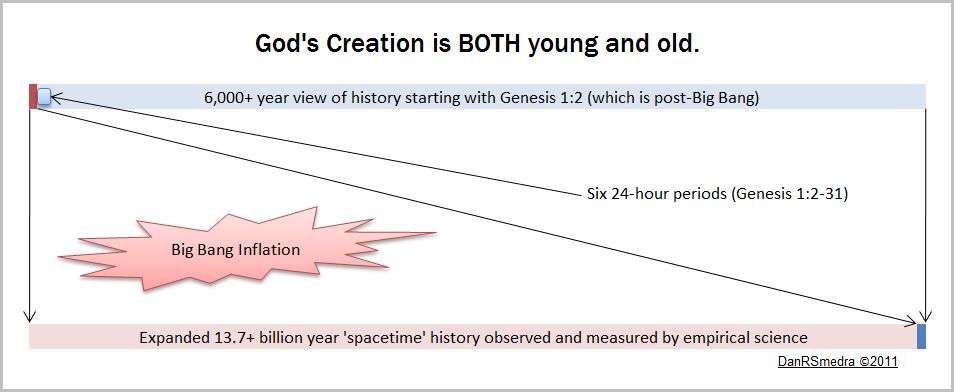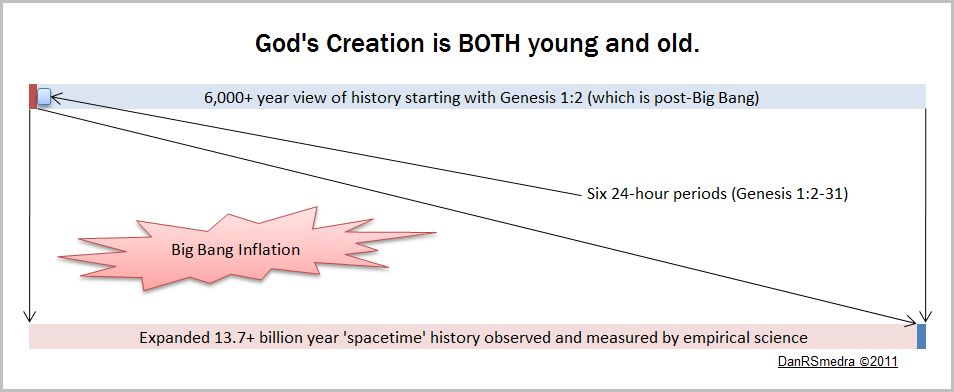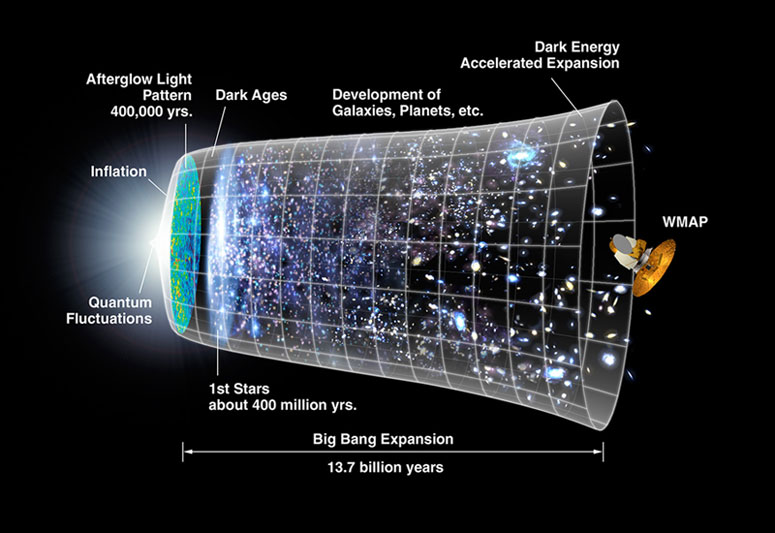The Fabric of God’s Creation—“Stretched” Spacetime
“In the beginning, God created the heavens and the earth.” Genesis 1:1
This very first verse of the Bible declares the work of the Creator. Like a giant canvas, the cosmos in its vast array was unfurled in an infinitesimally small moment, ready to receive the Grand Artist’s defining brush strokes—His quantum manipulations and subsequent 6 (24-hour) days of creation. By His design, this first verse simply states the fact. No modern scientific or cosmological details were included, out of some necessity, with any text written to be understood by either ancient or modern minds. (1)
However, subsequent narratives by biblical Prophets provide additional insights that are suggestive of the very first moment of Creation. Here are a few:
“He alone stretches out the heavens and treads on the waves of the sea. He is the Maker of the Bear and Orion, the Pleiades and the constellations of the south.” Job 9:8-9
“He wraps Himself in light as with a garment; He stretches out the heavens like a tent.” Psalm 104:2
“To Him who by wisdom made the heavens…who stretched out the earth above the waters…who made great lights…the sun to rule by day…moon and stars to rule by night; His mercy endures forever.” Psalm 136:5-9
“He stretches out the heavens like a canopy and spreads them out like a tent to live in.” Isaiah 40:22b
“This is what God the Lord says–He who created the heavens and stretched them out…” Isaiah 42:5a
“It is I who made the earth and created mankind upon it. My own hands stretched out the heavens; I marshaled their starry hosts.” Isaiah 45:12
“Who are you…that you forget the Lord your Maker, who stretched out the heavens, and laid the foundations of the earth…” Isaiah 51:12-13
“But God made the earth by his power; he founded the world by his wisdom and stretched out the heavens by his understanding.” Jeremiah 10:12
“He made the earth by his power; he founded the world by his wisdom and stretched out the heavens by his understanding.” Jeremiah 51:15
“The Lord, who stretches out the heavens, who lays the foundation of the earth, and who forms the spirit of man within him.” Zechariah 12:1
Similar language is found in: 2 Samuel 22:10; Job 26:7, 37:18; Psalm 18:9, 144:5; Isaiah 44:24, 48:13, 51:13; and Ezekiel 1:22. Even if God’s use of the Hebrew nâtâh (stretch) is metaphorical, it would still be describing an event that occurred “in the beginning.” Did God use such imagery to explain for the pre-scientific mind what He in fact accomplished at the beginning? Did science, specifically physics and cosmology, reach a milestone in natural understanding with its discovery of the initial hyper-distention (inflation) of the cosmos—what later became inaccurately known as the “Big Bang?”
This vignette is an introduction to some deeply profound subjects. Its purpose is to challenge conventional theories about the origin of the universe and how we understand its chronological age. I intentionally avoid technical scientific discussions of physics or cosmology, leaving qualified readers to explore that on their own.
To follow the remainder of the discussion, it will be essential for you to watch two of the PBS/NOVA video series THE FABRIC OF THE COSMOS written and narrated by noted Physicist Brian Greene. These are entitled: What is Space? and The Illusion of Time, both available under the Videos tab in the Menu bar. [fusion_builder_container hundred_percent=”yes” overflow=”visible”][fusion_builder_row][fusion_builder_column type=”1_1″ background_position=”left top” background_color=”” border_size=”” border_color=”” border_style=”solid” spacing=”yes” background_image=”” background_repeat=”no-repeat” padding=”” margin_top=”0px” margin_bottom=”0px” class=”” id=”” animation_type=”” animation_speed=”0.3″ animation_direction=”left” hide_on_mobile=”no” center_content=”no” min_height=”none”][Note: Greene is likely a philosophic naturalist, but at times uses the vernacular of a creationist or design. As you watch his videos or read his books, try to separate the empirical-based findings from philosophic speculation.]
Greene explains and contrasts the 18th-century cosmological view of Isaac Newton with Albert Einstein’s 20th-century discoveries. Theists who acknowledge the veracity of the Bible must learn to differentiate between these two worldviews and distinguish between different categories of scientific evidence, as well as the scientist’s philosophical framework for interpreting that evidence. (2)
Our goal here is for educated people with average intelligence to reconsider how they view the world around them and to build an intellectual “bridge” from the common naturalistic understanding of the cosmos to a new theistic worldview that reconciles both genuine scientific discovery and Biblical revelation.
Modern science has used observation, logic/reason, and technology to affirm that the cosmos is in fact…VAST in its size. Media (radio, television, movies, internet, etc.) as well as public schools, newspapers, and placards in natural history museums, continuously bombard us with the seemingly self-evident fact that the universe is billions of years old—13.84 billion as of the last calculation. But do you understand how these calculations are made?
Each time scientific technology is able to reach deeper into the depths of cosmic space, scientists are forced to adjust their estimate of the age of the universe upward—i.e. older. By simply mathematical equation (e.g. T=d÷c, where T equals time, d = distance, and c = the speed of light), scientists calculate the apparent time necessary for light to have traveled the vast expanses of the cosmos and thus estimate the age of the cosmos. It’s rather intuitively simple as long we accept the assumptions of the speed of light as a historical constant AND Isaac Newton’s metaphysical concept of absolute space and time. Time and again, the public is assured that the cosmos is billions of years old. (3)
Up until the recent discovery of the remnants of the hyper-inflation (what scientists call the “Big Bang”) (4), many scientists assumed the cosmos had no beginning (it was believed to be eternal or ageless) and that absolutely nothing was capable of traveling faster than the speed of light. However, scientists postulate the Big Bang’s hyper-expansion (the term “inflation” coined by physicist Alan Guth) occurred much faster—at near-infinite speed. Brian Greene contends “the size of the universe increased by a factor larger than a million, trillion, trillion in less than “a millionth of a trillionth of a trillionth of a second” all before the speed of light decreased to its current stable rate of about 186,282 miles per second. (5)
Using Einstein’s conceptual model of spacetime (6) which we learn from the 20th-century physics together with the facts of the Big Bang, we can now propose that BOTH the vast expanses of space, along with 13.84 billions years of time, were jointly stretched into existence in an infinitesimally small moment—the first moment of Creation. If so, then the universe did not progressively “evolve” over 13.84 billion years according to our normal, metaphysical experience of the flow of time.
Maybe it is this perspective difference (Newton vs. Einstein) that explains why a large number of scientists, the public, and even some well-meaning Christians are trapped in the evolutionary worldview. Was the integrated fabric of spacetime stretched into existence in the first sentence of the Bible…“In the beginning…”? Did both condensed space and time unravel together, as at least a four-dimensional fabric of reality was “stretched” into existence? With the Scripture account, the Creation narrative is non-sequential, literarily speaking. Chapter one provides an overview; chapter two provides additional detail for Chapter one. Did the fabric of spacetime unfold just prior to Genesis 1:2? And did the Spirit of God move the Prophets, Isaiah and Jeremiah in their written revelations, to describe (in illustrative fashion) that first moment of Creation, as I quoted above?
If so, this explanation offers coherence for both the scientific and biblical records. It is both simple and profound…one that Einstein could admire. From the big picture perspective, God’s universe is then BOTH young and old—”stretched” spacetime. (7)
“This is what God the Lord says–He who created the heavens and stretched them out, who spread out the earth and all that comes out of it, who gives breath to its people, and life to those who walk on it.” Isaiah 42:5
As mentioned at the start, the scientific details of the hyper-distention of space and the unfurling of time are not specifically stated in the Genesis narrative. However, nothing prevents Genesis 1:1 (“In the beginning, God created the heavens and the earth.”) from implicitly containing the scientific reality of the Big Bang, without the naturalistic assumptions added by secular scientists of course. Genesis 1:2 records the second moment of Creation, the beginning of a potential ‘quantum’ 24-hour day in which time ‘normalized’ according to our common experience and celestial understanding. [Note: This model should not be confused with the 19th-century “Gap Theory,” which posits eons of time between Genesis 1:1 and 1:2. In this model, no ‘time gap’ between these two verses of the Bible is necessary.] Here’s a graphic that seeks to capture what I’ve just described.
The two bars [top blue and bottom red] in the graph are two different representations of cosmic history. The top blue is history as recorded in the biblical narrative, while the bottom red is the history of the scientific record. The small, dark red rectangle in the upper left represents the super-condensed *spacetime* from which God created the “heavens and the earth” ex-nihilo, which then was “stretched” into the multidimensional, spacetime fabric. The six literal, 24-hour periods recorded in Genesis 1:2-2:1 follow this space hyper-distention/time elongation of the Big Bang. Various quantum and cosmological changes potentially occur in the early Genesis 1:2-8 narrative. The small, dark blue rectangle in the lower right corner represents the biblical and contemporary history, dwarfed by the “spacetime eruption,” which did not ‘evolve’, but rather came into existence in an instant. The perspective of scientific discovery is from the platform of that small, dark blue rectangle…looking back through the corridor of elongated time.
“For the scientist who has lived by his faith in the power of reason, the story ends like a bad dream. He has scaled the mountains of ignorance; he is about to conquer the highest peak; as he pulls himself over the final rock, he is greeted by a band of theologians who have been sitting there for centuries.”
“Now we see how the astronomical evidence supports the biblical view of the origin of the world….the essential elements in the astronomical and biblical accounts of Genesis are the same. Consider the enormousness of the problem: Science has proved that the universe exploded into being at a certain moment. It asks: ‘What cause produced this effect? Who or what put the matter or energy into the universe?’ And science cannot answer these questions.
“There is a strange ring of feeling and emotion in these reactions [of scientists to evidence that the universe had a sudden beginning]. They come from the heart whereas you would expect the judgments to come from the brain. Why? I think part of the answer is that scientists cannot bear the thought of a natural phenomenon that cannot be explained, even with unlimited time and money. There is a kind of religion in science, it is the religion of a person who believes there are order and harmony in the universe, and every effect must have its cause, [but still believes that] there is no first cause…
“This religious faith of the scientist is violated by the discovery that the world had a beginning under conditions in which the known laws of physics are not valid, and as a product of forces or circumstances, we cannot discover. When that happens, the scientist has lost control…” Dr. Robert Jastrow – astronomer, physicist, and cosmologist.
_________________________________________
(1) Portions of the book of First Corinthians provides insight as to why empirical evidence gathered by humankind alone cannot be substituted for biblical faith.
“For it is written, ‘I will destroy the wisdom of the wise; the intelligence of the intelligent I will frustrate’. Where is the wise man? Where is the scholar? Where is the philosopher of this age? Has not God made foolish the wisdom of the world? For since in the wisdom of God the world through its wisdom did not know Him, God was pleased through the foolishness of what was preached to save those who believe (exercise faith).” “He [God] chose the lowly things of this world and the despised things–and the things that are not–to nullify the things that are, so that no one may boast before Him.” Pride is the universal obstacle, for “…without faith it is impossible to please God, because anyone who comes to Him must believe that He exists and that He rewards those who earnestly see Him.” 1 Cor. 1:19-21, 28-29. Hebrews 11:6.
(2) The various books by author Brian Greene provide in-depth detail regarding 20th-century discoveries in physics, e.g. The Elegant Universe and The Fabric of the Cosmos: Space, Time, and the Texture of Reality. There are four videos in this PBS NOVA series The Fabric of the Cosmos. Be aware that many of today’s modern physicists travel far beyond the bounds of empirical science and into the realms of metaphysical speculation. The third and fourth videos in this series are that type of speculation. Nevertheless, Brian Greene’s books and videos are a great help in making the necessary mental switch from the narrower metaphysical assumptions of Newton to Albert Einstein’s 20th-century view of spacetime. Understanding the concept of spacetime is a necessary prerequisite for reconciling modern cosmology with the biblical view of Creation. Also, don’t miss Dr. Walt Brown’s excellent IN THE BEGINNING: Compelling Evidence for Creation and the Flood, 8th Edition.
(3) The apparent age of the universe is the corresponding basis for the fallacious theory of macro-evolution—all complex life was spawned and developed from small biological mutations over very long—billions, maybe even trillions of years.
(4) A distinction must be made here in my use of the term “Big Bang.” By “Big Bang,” I simply mean the physical phenomenon (event), irrespective of any implied causation. Those scientists who claim the Big Bang had “no cause” are making a philosophic/religious statement that goes beyond the limits of empirical science. The honest response is, “At this time, science cannot determine the cause for the Big Bang.”
(5) Many of today’s scientists who study the cosmos (cosmologists), use the common consensus of naturalism as the foundation (presupposition) for their work. While Einstein and many physicists posit “the fabric of spacetime,” their application of the concept seems speculative and arbitrary. Follow this closely. For me, one of the biggest puzzles is their visualization of the Big Bang, as seen in the graphic below. The illustration shows a separation of the initial hyper-distention (“inflation”) of 3D space from the 4th dimension of time. I can find no explanation for this. Why do physicists imagine an initial Big Bang “inflation” involving space, then ADD ON 13.84 billion years of time. Why not. Time is the least understood phenomenon. For them, scientists were not there to confirm anything, and thus the chronologies an arbitrary constructs driven by philosophic assumptions. Why can’t 99.9 percent of time be folded back into the initial inflation? And even more curious, how can astrophysicists calculate 380,000 years (shown on the most recent slides and charts) from the initial point of Creation to the formation of light? (I wrote both Brian Greene and Alan Guth asking for an explanation. To date, neither ever responded, but I’m still hopeful.) Is it possible most cosmologists are using a Big Bang visual model that conveniently coincides with their Newtonian premise, naturalistic assumptions, and biological evolutionary model, rather than with the concept of Einstein’s spacetime fabric?
(6) Einstein’s concept of the “consolidated fabric of space AND time” has been questioned, challenged, accepted, confirmed, yet rejected by some in the scientific community. A recent scientific experiment confirmed the premise of Einstein’s theories.
(7) This Creation-based model of cosmology also offers an alternative to both progressive and day-age forms of old Earth creationism, e.g., Hugh Ross (Christian) or Gerald Schroeder (Jewish).[/fusion_builder_column][/fusion_builder_row][/fusion_builder_container]



